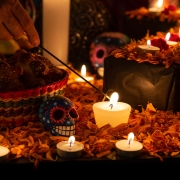This post is also available in:
![]() Spanish
Spanish

Towards the end of October, the spicy fragrance of copal incense begins to waft through the air and there is a whisper on the wind wherever you are in Mexico. You’ll notice bunches and garlands of cempasuchitl or orange marigolds that seem to glow in the sun, red cockscomb flowers, purple daisies, white lilies and gypsophila everywhere. There are piles of pan de muerto, candy skulls, candles and cut tissue paper in stores and markets as people begin to prepare their Dia de Muertos altars in honor of loved ones who have passed. You can see these altars at Royal Resorts and in Cancun, Playa del Carmen and elsewhere in the Mexican Caribbean and Yucatan.
One of Mexico’s richest and most colorful traditions, Día de Muertos is observed on November 1 and 2, and is on the World Heritage list. At this time of year, Mexicans believe that the souls of the dead come back to the world of the living for a short time. They welcome their loved ones with altars laden with flowers, food, treasured possessions, and other offerings – each item is full of symbolism–, and with candlelit vigils, masses and serenades.
You may want to plan a visit to Xcaret for the Festival de Tradiciones de Vida y Muerte, a celebration of timeless Day of the Dead customs, held from October 30 to November 2. The Festival program features processions, altars, traditional cuisine, art exhibits, music, dance, theater, children’s events and a visit to the colorful Mexican cemetery. Maya communities from Quintana Roo and Yucatan participate and another Mexican state with different traditions is always invited as a special guest. This year, it is the land of the monarch butterfly itself, Michoacan, a mountainous state rich in music, dance, crafts and cuisine.
In Yucatan, the Day of the Dead is known as Hanal Pixan or “feast of the souls” and altars spring up in Valladolid, Izamal and in the state capital Merida, where Dia de Muertos events also include the huge Paseo de las Animas procession from the city cemetery.
Ask at the Thomas More Travel desk about Xcaret trips and the Festival de Tradiciones de Vida y Muerte.

